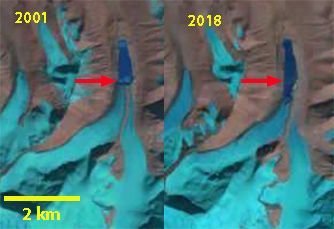June 30, 2022
Zarilang Glacier, China Retreat and Lake Expansion
Posted by Mauri Pelto
Zarilang Glacier in 1998 and 2021 Landsat images illustrating glacier retreat and lake expansion. Point A marks the junction of two tributaries.
Zarilang Glacier, China flows north from the Bhutan border is in the Yarlung Zangbo River watershed draining the northwest flank of Kula Kangri. Yarlung Zangbo which becomes the Brahmaputra River supplies the Zangmu Dam (510 MW), online in 2015, that produces 2.5 billion kwh of electricity a year. Wang et al (2021) observe a significant increase in discharge of Yarlung Zangbo due to glacier melt and permafrost degradation. Zhang et al (2020) observed glacier retreat leading to lake expansion averaging 20 m/year in the Himalaya for the 2008-2016 period, with Yarlung Zangbo basin having the highest average rate of lake expansion.
In 1998, Zarilang Glacier terminated in a proglacial lake that was 1.0 km long with an area of 0.24 km2, 1.8 km upglacier from the terminus was a significant junction at Point A, with a medial moraine marking the boundary extending to the terminus. In 2001 the calving front is 400 m wide and has retreated ~100 m since 1998. By 2014 the glacier has retreated into a narrowing portion of the lake. By 2018 the medial moraine marks the eastern margin of the glacier, which means the eastern tributary is no longer reaching the lake. In 2021 the glacier has retreated 700 m and the lake is now 1.7 km long and has an area of 0.50 km2. In 2022 the calving front is 200 m wide and the glacier terminates 900 m from the junction at Point A, and the eastern tributary ends 100 m short of the lake. The lake area has doubled since 1998, which is a higher rate than the already high rate of 51% globally for glacial lakes noted by Shugar et al (2019) for glacial lakes 1990-2018.
Sun et al (2022) rated the hazard of a glacier lake outburst flood from this lake as low. The retreat is similar in scope to that of other glaciers retreating in expanding lakes in this region of China such as Sepu Kangri and Quiaqing Glacier. Examining glacier mass loss in the Himalaya King et al (2019) noted that lake terminating glaciers lost 30% more volume than other Himalayan glacier from.
Sentinel images in 2022 of Zarilang Glacier and the glacial lake. On May 31 there is some lake ice left. Note the medial moraine now is the eastern margin of the terminus.
Zarilang Glacier in 2001 and 2018 Landsat images illustrating glacier retreat and lake expansion. Point A marks the junction of two tributaries.





 Dean of Academic Affairs at Nichols College and Professor of Environmental Science at Nichols College in Massachusetts since 1989. Glaciologist directing the North Cascade Glacier Climate Project since 1984. This project monitors the mass balance and behavior of more glaciers than any other in North America.
Dean of Academic Affairs at Nichols College and Professor of Environmental Science at Nichols College in Massachusetts since 1989. Glaciologist directing the North Cascade Glacier Climate Project since 1984. This project monitors the mass balance and behavior of more glaciers than any other in North America.